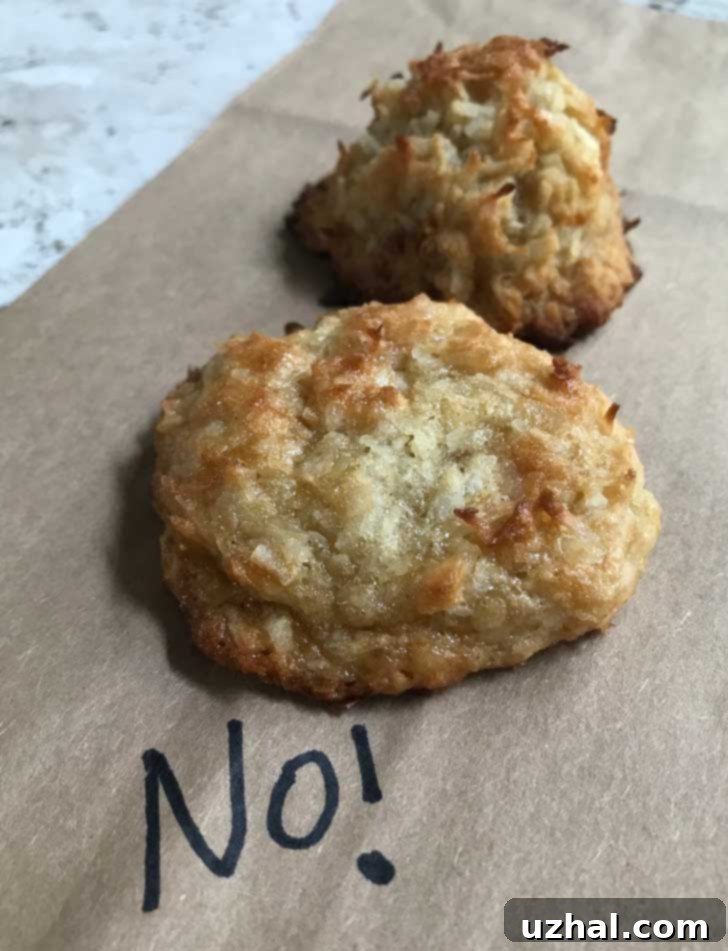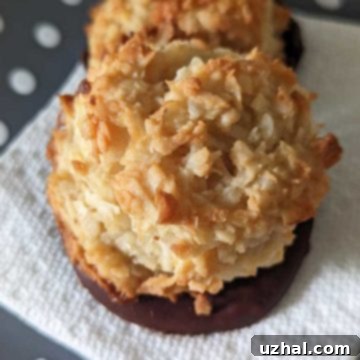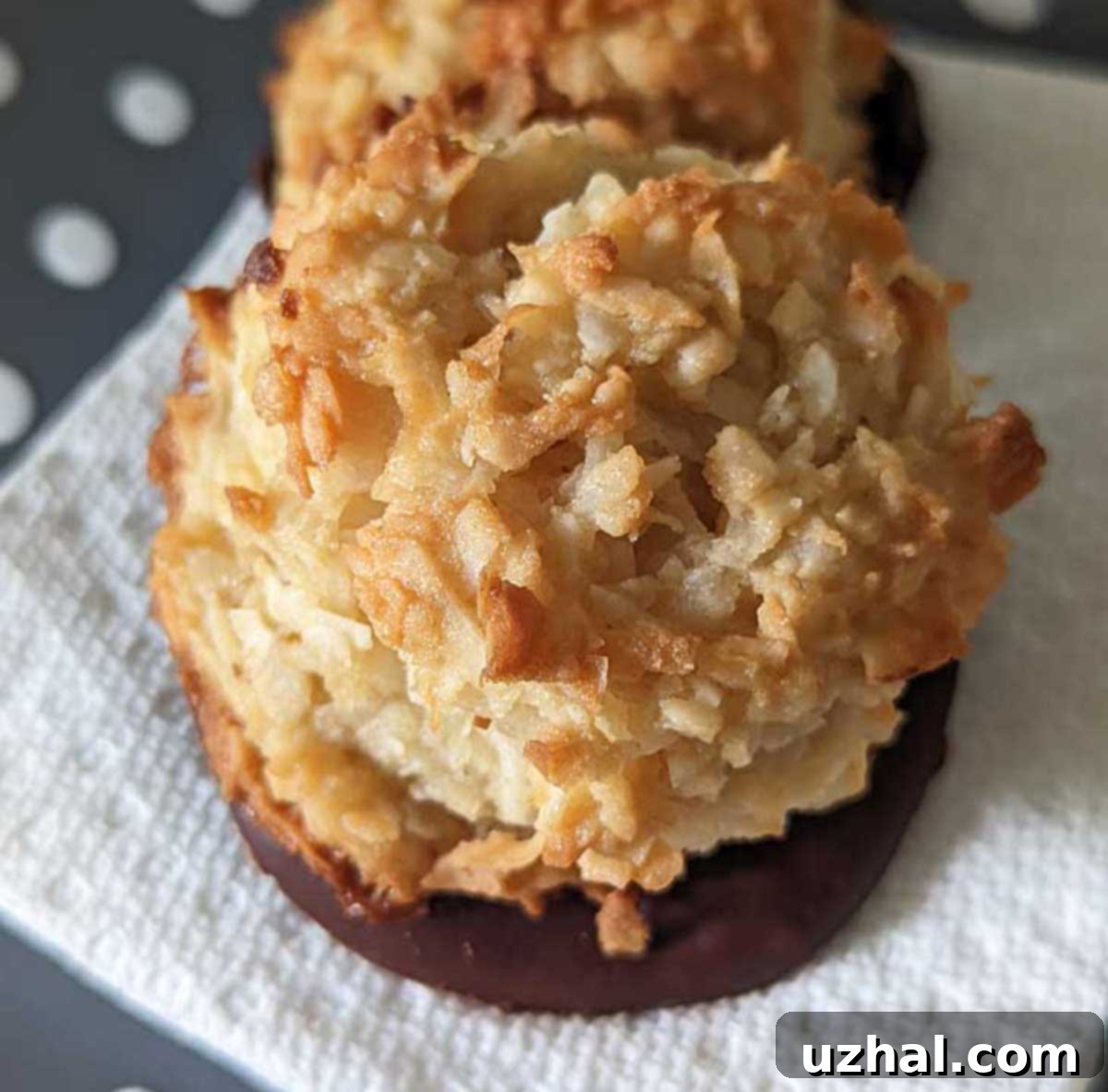Irresistible Gluten-Free Vegan Chocolate Dipped Coconut Macaroons: Your Ultimate Guide
Stepping into the world of delightful confectionery can sometimes be a bit confusing, especially when terms like “macaron” and “macaroon” are thrown around. For clarity, let’s distinguish these two popular treats right from the start. Macarons are those elegant, colorful French sandwich cookies, typically made with almond flour and egg whites, known for their delicate shells and creamy fillings. Macaroons, on the other hand, are delightfully rustic and chewy coconut cookies, often bound with eggs, flour, and sometimes condensed milk.
While we cherish both for their unique charms, our culinary adventure today focuses squarely on the latter – the humble yet heavenly coconut macaroon. What makes this particular recipe stand out? It’s a game-changer for those with dietary restrictions or anyone simply looking for a wholesome, plant-based alternative. Inspired by some leftover coconut from a Claremont Diner pie recipe, we’ve crafted these incredible Gluten-Free Vegan Coconut Macaroons, ensuring that everyone can indulge in their sweet, chewy goodness. The best part? Each one is generously dipped in rich, melted chocolate, elevating a simple treat to a truly decadent experience.

Unveiling the Magic of Vegan Chocolate Dipped Coconut Macaroons
Many traditional coconut macaroon recipes lean heavily on condensed milk for their signature chewy texture and caramelized flavor. While those are undeniably delicious, we’ve taken a different path to create a version that is both deeply satisfying and entirely plant-based. These gluten-free vegan macaroons ingeniously substitute full-fat canned coconut milk for condensed milk and utilize brown rice flour instead of conventional wheat flour. The result is nothing short of spectacular: cookies that are wonderfully sweet, incredibly chewy, and boast a rich, pronounced coconut flavor that sings with every bite.
The addition of chocolate is not just an afterthought here; it’s an integral part of the experience. We’ve ensured there’s just enough chocolate to satisfy even the most ardent chocoholic, providing a perfect counterpoint to the sweet coconut. The subtle bitterness and smooth texture of the dark chocolate base elevate these macaroons, making them a sophisticated treat. What’s truly remarkable about these cookies is their versatility. They’re fantastic at room temperature, but a unique characteristic that many enthusiasts, including us, adore is how utterly delicious they are straight out of the freezer. The chill enhances their chewiness and the chocolate becomes a firm, satisfying snap, creating a delightful textural contrast that keeps you coming back for more.
Mastering Gluten-Free Baking: Why Brown Rice Flour is Key
Navigating the world of gluten-free baking can sometimes feel like a delicate science, especially when it comes to achieving the right texture without gluten’s binding properties. For this specific vegan macaroon recipe, the choice of flour is paramount, and after extensive testing, we unequivocally recommend brown rice flour. Its fine texture and mild flavor make it an ideal candidate, providing structure and a slight crispness without overpowering the coconut. Brown rice flour absorbs liquid effectively, contributing to the desired chewy consistency of macaroons.
We conducted experiments using various gluten-free flour blends, including a popular 1:1 gluten-free baking blend (specifically, one called Good Measures). While 1:1 blends are convenient for many recipes, they often contain a mix of different starches (like potato starch, tapioca starch, cornstarch) and gums (like xanthan gum) that can behave unpredictably in certain formulations. In our tests, substituting a 1:1 blend for brown rice flour resulted in cookies that unfortunately spread too much, losing their characteristic macaroon shape and becoming flatter and less substantial. This spreading is often due to an imbalance in the blend’s components, which don’t provide the same structural integrity as brown rice flour in this particular context.
While other 1:1 blends might yield different results (and we plan to continue testing them), for now, to guarantee success and that perfect chewy, mounded shape, stick with brown rice flour. Brands like Bob’s Red Mill are widely available and consistently reliable. If your local grocery store doesn’t stock it, you can easily order it online. Don’t worry about having a whole bag left over; brown rice flour is a versatile staple in many gluten-free recipes, from breads to cakes and even savory dishes, so you’ll find plenty of uses for it beyond these delicious macaroons.

Flexible Baking: From Small Batches to Freezer Stash
This gluten-free vegan macaroon recipe is designed to yield 12 generous, delicious cookies, which is a perfect quantity for sharing or for keeping a steady supply of treats on hand. However, we understand that sometimes you might only want a small indulgence or need to use up specific quantities of ingredients. That’s why this recipe is incredibly flexible!
If you’re baking for just one or two coconut lovers, or if you simply have a smaller amount of leftover full-fat coconut milk or flaked coconut from other culinary projects, you can easily make a half batch. A small batch of 6 cookies works beautifully and is a fantastic way to prevent food waste. We’ve even successfully tested baking as few as 3 macaroons, proving just how adaptable this recipe is. While a tiny batch is certainly doable, we often recommend making at least 6. Why? Because these chocolate dipped macaroons store exceptionally well in the freezer. Having a small stash means you’re always just moments away from a perfect, cold, chewy treat without the need for immediate baking.
When storing, ensure they are placed in an airtight container in the freezer. They will maintain their delicious flavor and texture for several weeks, if not months. This makes them an excellent candidate for meal prepping your desserts or having a convenient option for unexpected guests. Simply pull them out and enjoy them frozen, or allow them to thaw for a few minutes at room temperature for a softer bite. The freezer also helps to set the chocolate base beautifully, preventing any mess and ensuring a satisfying snap.
A Closer Look at Your Ingredients for Dairy-Free Delight
The success of these vegan coconut macaroons hinges on a few key ingredients, each playing a crucial role in achieving the perfect flavor and texture. Understanding why each component is chosen will help you master the recipe and even experiment with confidence. Here’s a detailed rundown:
- Canned Coconut Milk (Full Fat, Not Lite): This is the superstar ingredient replacing traditional condensed milk and dairy. The full-fat variety is non-negotiable. Its high fat content is what provides the essential richness, creaminess, and binding power that condensed milk typically offers. Lite coconut milk simply won’t yield the same results in terms of texture or flavor, as it lacks the necessary density and fat for these chewy macaroons.
- Maple Syrup or Golden Syrup: Both of these natural sweeteners work wonderfully here. Maple syrup offers a distinct, warm flavor that complements coconut beautifully, while golden syrup provides a more neutral, caramelized sweetness. You can use either exclusively or a 50/50 blend for a nuanced flavor. If you opt to use unsweetened coconut flakes (which we’ll discuss below), you’ll want to increase the syrup amount by about 1 tablespoon (to 5 tablespoons total) to maintain the desired sweetness level.
- Brown Rice Flour: As highlighted earlier, this is your go-to gluten-free flour for this recipe. It provides the necessary structure and a slightly crisp edge while keeping the inside perfectly chewy. We’ve had consistent success with Bob’s Red Mill brand, known for its quality and consistency in gluten-free baking.
- Vanilla Extract: Often underestimated, the vanilla flavor is absolutely key in these macaroons. It enhances and rounds out the sweetness of the coconut and syrup, adding depth and a comforting aroma. Use a high-quality vanilla extract that you truly enjoy. For a premium touch, try a vanilla bean paste or a blend like Sonoma Syrups Vanilla Bean Crush, which combines Tahitian and Madagascar vanillas for an exquisite profile.
- Cream of Tartar & Baking Soda: In egg-free baking, these two leavening agents work in tandem. Cream of tartar acts as an acid, which, when combined with baking soda (a base) and moisture, creates carbon dioxide bubbles. This reaction helps to provide a slight lift and contributes to the tender, chewy texture of the macaroons, especially in the absence of eggs. While we haven’t tested baking powder as a direct substitute in this recipe, the combination of cream of tartar and baking soda has proven reliable.
- Sweetened Flaked Coconut (e.g., Baker’s Angel Flake Coconut): This is the backbone of your macaroons. Sweetened flaked coconut is readily available and provides both the bulk and additional sweetness/moisture that contribute to the perfect macaroon texture. While some similar recipes can be made with unsweetened coconut, this particular formulation is optimized for sweetened. If you wish to try unsweetened, be prepared to adjust the syrup as mentioned earlier, and potentially add a touch more liquid if the mixture feels too dry, as unsweetened coconut absorbs less moisture.
- Chocolate (Chips or Chopped Dark Chocolate): Any good quality chocolate will work for dipping! The beauty of this recipe’s dipping method is its simplicity – no messy bowl-dipping required. Whether you prefer milk, semi-sweet, or dark chocolate, choose one you love. We recommend using good quality chocolate chips or finely chopped dark chocolate (3-4 oz) for the best melting consistency and flavor.
- Giant Coconut Macaroons
- Chewy Chocolate Macaroons
- Miniature Coconut Macaroon Cheesecake
- Happy National Macaroon Day!
- Salted Caramel Macaroons
Recipe

Gluten-Free Vegan Chocolate Dipped Macaroons
Pin Recipe
Ingredients
- ⅔ cup canned coconut milk (full fat, not lite) (145 grams)
- ¼ cup maple syrup or golden syrup or half of each (80 grams)
- ⅓ cup brown rice flour (56 grams)
- 1 teaspoon vanilla extract
- ¼ teaspoon cream of tartar
- ¼ teaspoon baking soda
- 2 ¼ cups sweetened flaked coconut (225-250 grams)
- ½ cup best quality chocolate chips or about 3 or 4 oz dark chocolate, chopped
Instructions
-
Preheat your oven to 375°F (190°C) and line one large baking sheet with parchment paper. If you are using a sheet pan smaller than 13×18 inches, you might need to use two baking sheets, or bake your macaroons in two batches, swapping out the parchment paper each time.
-
In a medium mixing bowl, combine the full-fat coconut milk, maple syrup (or golden syrup, or a mix of both), brown rice flour, and vanilla extract. Stir these ingredients together thoroughly until they are completely smooth and evenly blended.
-
Next, add the cream of tartar and baking soda to the mixture and stir very well to ensure they are fully incorporated. Then, fold in the sweetened flaked coconut. If you are experimenting with unsweetened coconut, start by stirring in 2 cups and add more incrementally as needed. Please note that exact amounts for unsweetened coconut cannot be provided at this time as it hasn’t been fully tested with this specific recipe.
-
The macaroon batter should be cohesive enough to hold its shape when scooped, though it might still appear somewhat loose. If the batter feels too loose to pack firmly, let it rest for approximately 10 minutes to allow the flour and coconut to absorb more liquid. Using a generously packed medium cookie scoop, form 12 uniform balls and place them onto the prepared parchment-lined baking sheet(s).
-
Bake one sheet at a time for about 14 minutes, or until the macaroons are beautifully golden brown. For those who, like us, prefer their macaroons with a deeper, richer color and slightly crispier edges, you may extend the baking time by a few more minutes. Once baked, remove the macaroons from the oven and let them cool completely on the baking sheet before gently peeling them away from the parchment paper.
-
Prepare your chocolate dip by melting the chocolate chips (or chopped dark chocolate). You can do this in the microwave at 50% power, stirring diligently every 60 seconds until smooth and fully melted. Alternatively, use a double boiler method for a more controlled melt.
-
Line a couple of dinner plates or a small baking sheet (anything that fits into your freezer) with fresh parchment paper. Spoon approximately a tablespoon-sized circle of melted chocolate onto the parchment for each macaroon. Immediately place one cooled macaroon directly onto each chocolate puddle, pressing down gently to create a thick, flat chocolate base. Continue this process with all the remaining macaroons. Transfer the plates/sheets to the freezer for about 20 minutes, or until the chocolate is completely set and firm. Once set, they will easily peel away from the parchment.
-
Store your finished chocolate dipped macaroons in an airtight container in the freezer. They are absolutely delicious served cold and firm, offering a wonderful textural contrast!
Notes
This recipe is a thoughtful adaptation from The Sweet Freedom Bakery’s original. Their recipe initially called for unsweetened coconut milk and agave. However, since agave isn’t a staple in my kitchen and I often have sweetened Angel Flake coconut on hand, I modified the recipe to use readily available sweetened flaked coconut and maple syrup. If you prefer to use unsweetened coconut in your batch, remember to increase the maple or golden syrup by 1 tablespoon to balance the sweetness.
